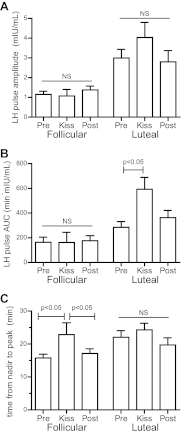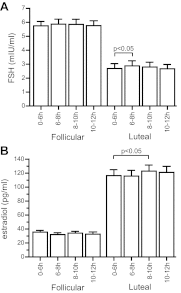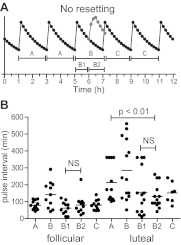Kisspeptin administration to women: a window into endogenous kisspeptin secretion and GnRH responsiveness across the menstrual cycle
- PMID: 22577171
- PMCID: PMC3410261
- DOI: 10.1210/jc.2012-1282
Kisspeptin administration to women: a window into endogenous kisspeptin secretion and GnRH responsiveness across the menstrual cycle
Abstract
Context: Kisspeptin is the most powerful known stimulus of GnRH-induced LH secretion across mammalian species. However, the effects of kisspeptin are just being explored, and the dynamics of kisspeptin responsiveness across the menstrual cycle are incompletely understood.
Objective: The objective of the study was to characterize the effects of kisspeptin on GnRH secretion in healthy women in different phases of the menstrual cycle.
Participants and intervention: Ten women in the early follicular phase, three women in the late follicular (preovulatory) phase, and 14 women in the midluteal phase received a bolus of kisspeptin 112-121 0.24 nmol/kg iv. An additional four women in the early to midfollicular phase received kisspeptin 112-121 0.72 nmol/kg iv.
Results: The response to kisspeptin varied depending on the phase of the menstrual cycle. LH pulses were observed immediately after kisspeptin administration in all luteal and preovulatory women. However, only half the women in the early follicular phase had unambiguous kisspeptin responses. Increasing the kisspeptin dose did not increase the LH response in early to midfollicular phase women. Kisspeptin did not appear to reset the GnRH pulse generator in women as it does in men.
Conclusions: Differences in responses to exogenous kisspeptin across the menstrual cycle suggest that kisspeptin tone is higher in the early follicular phase compared with other cycle phases. The mechanisms that determine the timing of GnRH pulse generation in men and women appear to be distinct.
Figures




References
-
- Seminara SB, Messager S, Chatzidaki EE, Thresher RR, Acierno JS, Jr, Shagoury JK, Bo-Abbas Y, Kuohung W, Schwinof KM, Hendrick AG, Zahn D, Dixon J, Kaiser UB, Slaugenhaupt SA, Gusella JF, O'Rahilly S, Carlton MB, Crowley WF, Jr, Aparicio SA, Colledge WH. 2003. The GPR54 gene as a regulator of puberty. N Engl J Med 349:1614–1627 - PubMed
-
- Gottsch ML, Cunningham MJ, Smith JT, Popa SM, Acohido BV, Crowley WF, Seminara S, Clifton DK, Steiner RA. 2004. A role for kisspeptins in the regulation of gonadotropin secretion in the mouse. Endocrinology 145:4073–4077 - PubMed
-
- Messager S, Chatzidaki EE, Ma D, Hendrick AG, Zahn D, Dixon J, Thresher RR, Malinge I, Lomet D, Carlton MB, Colledge WH, Caraty A, Aparicio SA. 2005. Kisspeptin directly stimulates gonadotropin-releasing hormone release via G protein-coupled receptor 54. Proc Natl Acad Sci USA 102:1761–1766 - PMC - PubMed
-
- Dhillo WS, Chaudhri OB, Patterson M, Thompson EL, Murphy KG, Badman MK, McGowan BM, Amber V, Patel S, Ghatei MA, Bloom SR. 2005. Kisspeptin-54 stimulates the hypothalamic-pituitary gonadal axis in human males. J Clin Endocrinol Metab 90:6609–6615 - PubMed

